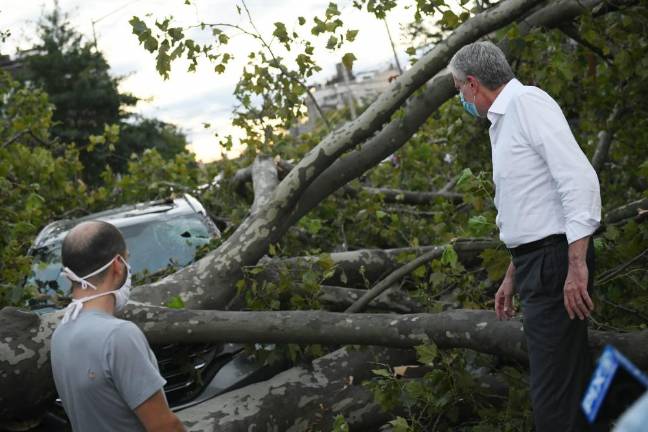Wind and Water Worries
How to prepare for hurricane season, post-Isaias

It’s August, hot, humid and right smack in the middle of New York’s hurricane season which runs from June 1 to November 1 every year. Ordinarily, that would mean about 12 named storms, but this year the National Oceanic and Atmospheric Administration (NOAA) says we may see 25 with up to six major Atlantic hurricanes.
That means you can expect to hear the words hurricane watch, hurricane warning, and just plain hurricane a lot. For the non-meteorologists among us, a watch means a hurricane is possible but not certain; a warning says tropical storm conditions with winds up to about 40 miles an hour exist and may rev up to hurricane speed in a day or so; hurricane alone means a storm with sustained winds 74 miles an hour or greater is about to hit.
Things don’t have to get that level to make problems. When a weakened Isaias made its way through town a week or so ago, it was still strong enough to knock down trees and knock out power in wide swaths of Queens and Brooklyn. (Manhattan’s power lines are mostly underground so we managed to avoid storm damage – but not the effects of a lightening strike which left much of the upper island temporarily in the dark.)
Many if not most of Manhattanites live in multi-story buildings. If that’s you and multi-story means “high rise” and you are on the 10th floor or higher, stay away from the windows which wind might shatter and maybe move down to stay with a friend on a lower floor. If you live in a basement apartment, go in in the opposite direction because as Superstorm Sandy showed eight years ago, this is an island with water, water all around, sometimes right up to and into our homes and offices.
The proper name for this phenomenon is storm surge defined as water pushed ashore by powerful oncoming hurricane winds. Based on the risk of flooding, New York City lists six specific zone categories from which residents may be ordered to leave for higher ground. And yes, even those living in high rise buildings in one of these zones may experience the unpleasant effects of a storm surge that floods basements and interrupts electrical service including elevators.
Prepare a Go Bag
As always, the best way to deal with the possibility of a problem is to plan for it in advance. Start by clicking on www.floodhelpny.org a site which enables you to locate your own building and see if it sits in a potential flood evacuation zone. Or go to https://www1.nyc.gov/assets/em/html/know-your-zone/knowyourzone.html which has even more info on what to do, including how to prepare a go-bag with:
- Copies of I.D. documents such as a driver’s license and a birth certificate
- Copies of your credit cards
- Copies of insurance cards including home owner’s and medical insurance
- Copies of at least one bank statement
- List of your meds by name, with dose and how to take them
- An extra set of house keys, car keys and keys to lockers or safety deposit boxes
- Cash in small bills
- If there’s room, stick in a flashlight and small radio with extra batteries
- Finally: Think Fido and Fluffy. Whether yours is a pet or a service animal, the rules say they’ll be welcome at any evacuation shelter, but it’s unlikely there will be pet food or pet meds, so add some as well.
Now, stash the go-bag in a safe place. Take it out from time to time to make sure all documents are up to date. If you’ve included an emergency supply of pills or potions, check to see that they have not expired.
Then sit back and relax.
Maybe it won’t rain after all.